High Impact Tutoring Built By Math Experts
Personalized standards-aligned one-on-one math tutoring for schools and districts
In order to access this I need to be confident with:
Substitution Coordinate plane Linear graph Exponents Laws of exponentsExponential function graph
Here you will learn about exponential function graphs, including recognizing and sketching exponential function graphs, plotting and interpreting exponential function graphs.
Students will first learn about exponential function graphs as part of functions in functions in high school.
What is an exponential function graph?
An exponential function graph is a representation of an exponential function of the form y=k^x where x and y are variables and k is a constant (a numerical value).
x is the exponent and k is the base.
The graph of an exponential function can represent either exponential growth or exponential decay.
When k is greater than 1, it is a growth curve. It can be used to represent population growth or compound interest. As x increases, so does y.
For example,
y=2^x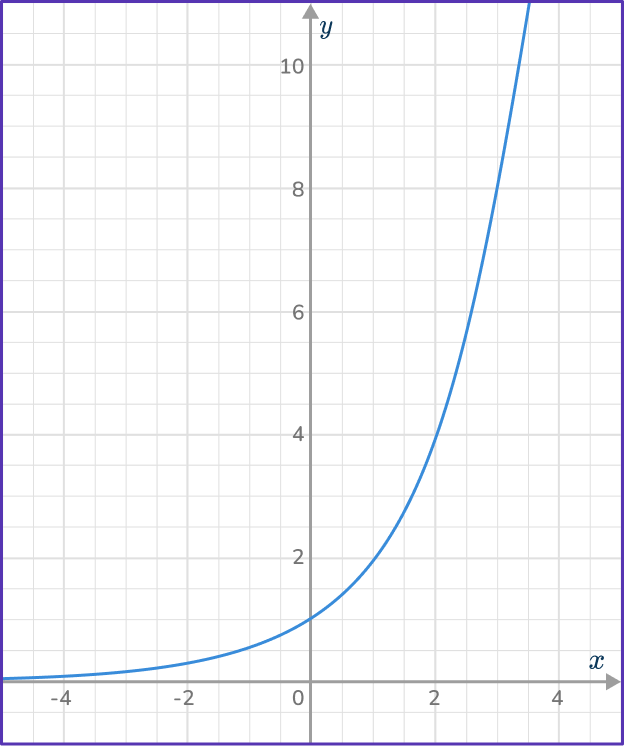
![[FREE] Types of Graphs Check for Understanding Quiz (Grade 5 to 8)](https://thirdspacelearning.com/wp-content/uploads/2023/07/Types-of-graphs-check-for-understanding-quiz-listing-image-.png)
[FREE] Types of Graphs Check for Understanding Quiz (Grade 5 to 8)
![[FREE] Types of Graphs Check for Understanding Quiz (Grade 5 to 8)](https://thirdspacelearning.com/wp-content/uploads/2023/07/Types-of-graphs-check-for-understanding-quiz-listing-image-.png)
Use this quiz to check your grade 5 to 8 students’ understanding of type of graphs. 15+ questions with answers covering a range of 5th and 6th grade type of graphs topics to identify areas of strength and support!
DOWNLOAD FREE![[FREE] Types of Graphs Check for Understanding Quiz (Grade 5 to 8)](https://thirdspacelearning.com/wp-content/uploads/2023/07/Types-of-graphs-check-for-understanding-quiz-listing-image-.png)
[FREE] Types of Graphs Check for Understanding Quiz (Grade 5 to 8)
![[FREE] Types of Graphs Check for Understanding Quiz (Grade 5 to 8)](https://thirdspacelearning.com/wp-content/uploads/2023/07/Types-of-graphs-check-for-understanding-quiz-listing-image-.png)
Use this quiz to check your grade 5 to 8 students’ understanding of type of graphs. 15+ questions with answers covering a range of 5th and 6th grade type of graphs topics to identify areas of strength and support!
DOWNLOAD FREEWhen k is less than 1, it is a decay curve. It can be used to represent (for example) radioactive decay.
For example,
y=(\cfrac{1}{2})^x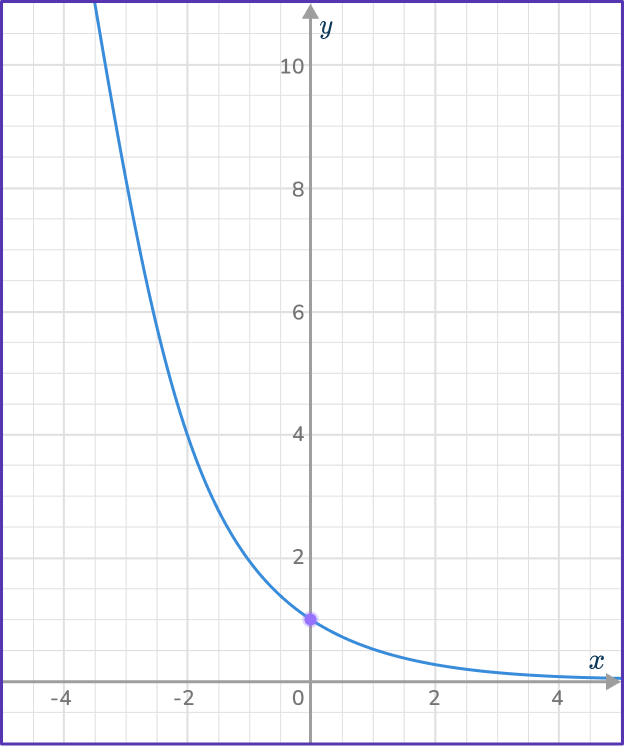
The y -intercept ( at x=0) is 1 since anything raised to the power 0 is 1.
See also: Anything to the power of 0
The x -axis is an asymptote to the curve. The curve gets very close to the horizontal asymptote but does not touch it. This is because y
y=k^x is a basic exponential function. There are more complex exponential functions of the form y=ab^x.
The graphs look similar to the ones above, they have an exponent x, they have base b and the y -intercept is a \, ( this is because when x=0, y=a\times{b^0}=a\times{1}=a). For example, y=4\times 3^x
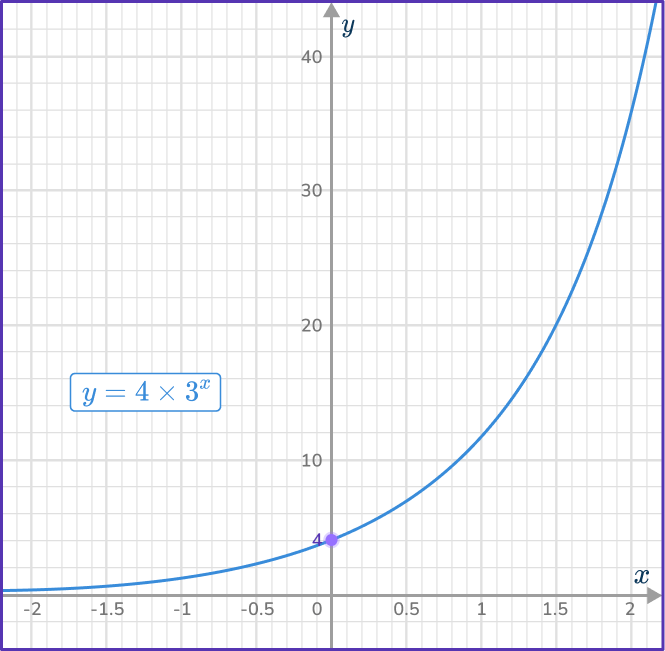
What is an exponential function graph?
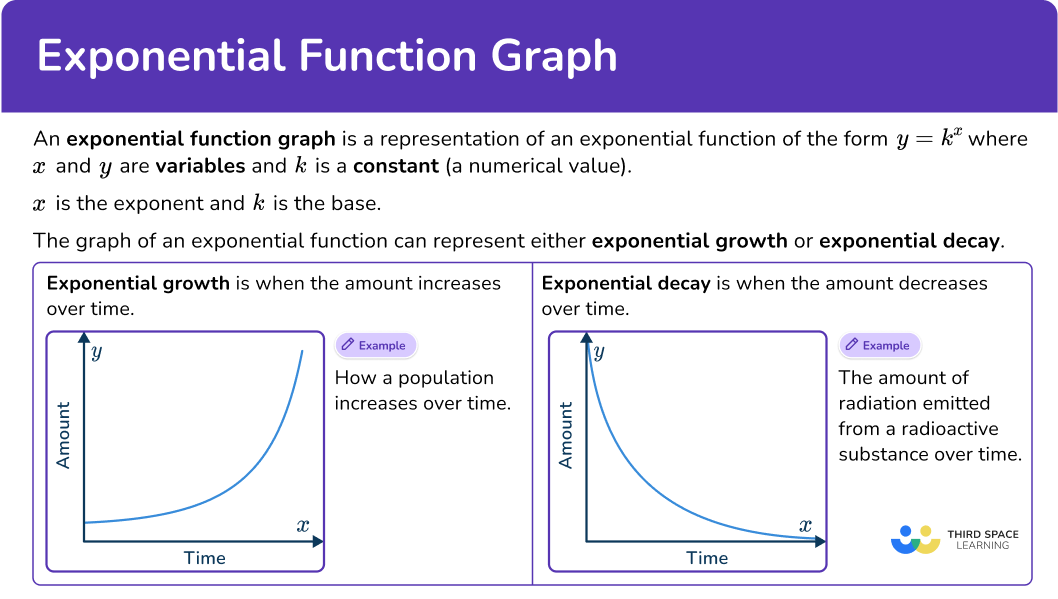
Common Core State Standards
How does this relate to high school math?
- Functions – Interpreting Functions (HS.F-IF.C.7e)
Graph functions expressed symbolically and show key features of the graph, by hand in simple cases and using technology for more complicated cases. Graph exponential and logarithmic functions, showing intercepts and end behavior, and trigonometric functions, showing period, midline, and amplitude.
How to recognize an exponential graph
In order to recognize an exponential graph:
- Identify any linear/ quadratic/ cubic or inverse (reciprocal) functions.
- Identify the exponential function.
Recognizing an exponential function graph examples
Example 1: recognize exponential function graphs
Which is the correct equation for the graph?
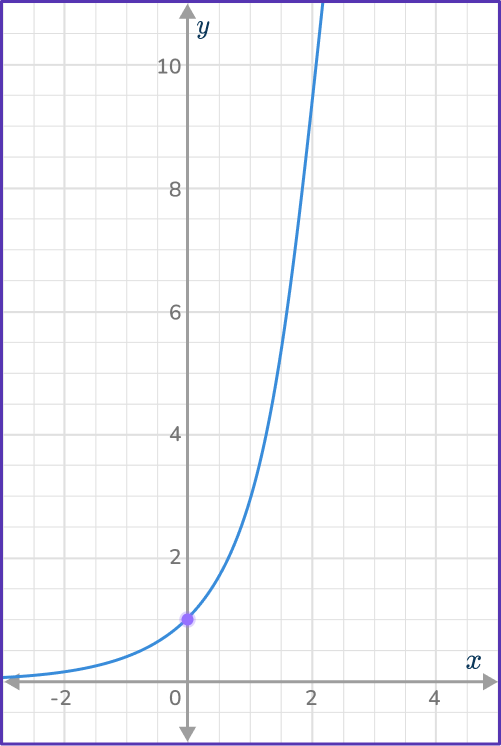
- Identify any linear/ quadratic/ cubic or inverse (reciprocal) functions.
y=x^{2}+3 is a quadratic function; its graph would be a parabola.
y=3x+1 is a linear function; its graph would be a straight line.
y=\cfrac{3}{x} is an inverse function; its graph would be a hyperbola.
2Identify the exponential function.
y=3^{x} is an exponential function. It has x as the exponent and the base is 3. The base is greater than 1, so the graph is a growth curve.
Example 2: recognize exponential graphs
Which is the correct equation for the graph?
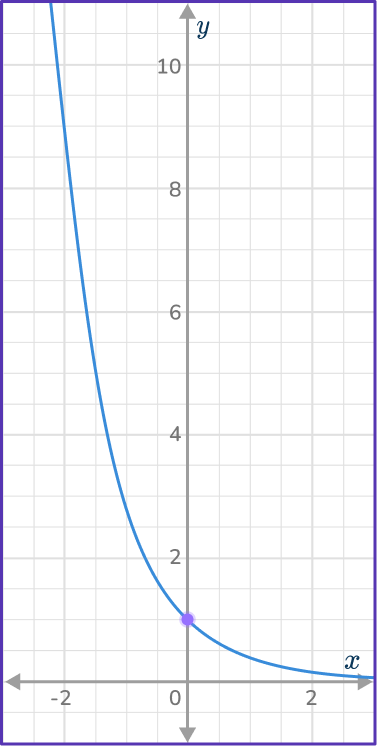
Identify any linear/ quadratic/ cubic or inverse (reciprocal) functions.
y=1-3x is a linear function; its graph would be a straight line.
y=x^{2}-3 is a quadratic function; its graph would be a parabola.
y=x^{3} is a cubic function.
Identify the exponential function.
y\left(\cfrac{1}{3}\right)^{x} is an exponential function. It has x as the exponent and the base is \cfrac{1}{3}. The base is less than 1, so the graph is a decay curve.
How to plot an exponential graph
In order to plot an exponential function graph:
- Complete the table of values.
- Plot the coordinates.
- Draw a smooth curve through the points.
Plotting an exponential function graph examples
Example 3: plot exponential graphs
Draw the curve of y=2^x for - \, 1\leq{x}\leq3.
Complete the table of values.

Plot the coordinates.
Draw an x -axis and a y -axis. It is best practice to use a pencil and plot the coordinates using small crosses.
The coordinates would be (- \, 1, 0.5), (0, 1) and so on.
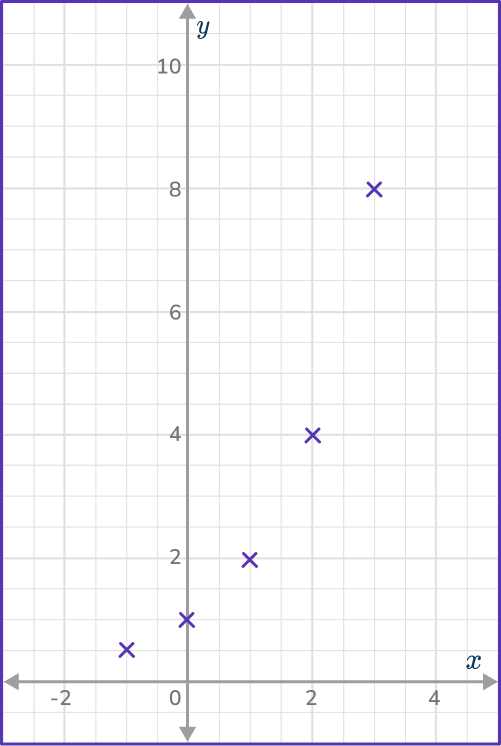
Draw a smooth curve through the points.
Use a pencil and turn the paper around if it makes it easier for you.
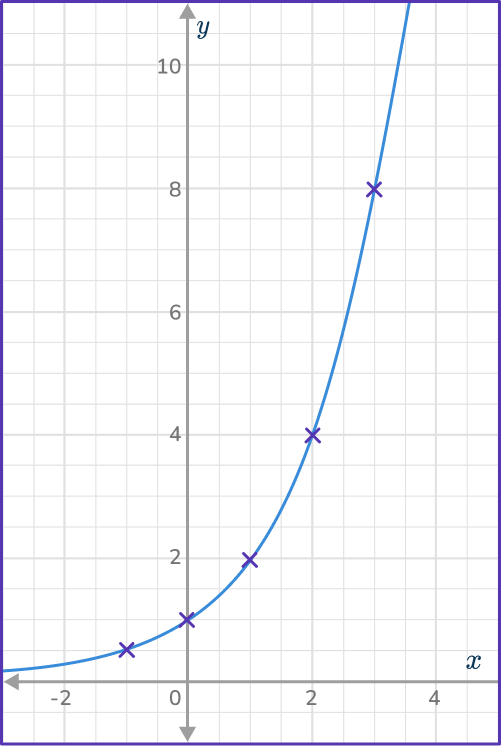
Note: Technically anything can be used as the initial values, but to see the y -intercept and the overall behavior of the curve, values around x=0 are the best to use. These values are also typically the easiest to calculate when finding the equation of an exponential function ( shown in Example 5 and 6.)
Example 4: plot exponential graphs
Draw the curve of y=\left(\cfrac{1}{2}\right)^x for - \, 2\leq{x}\leq2.
Complete the table of values.

Plot the coordinates.
Draw an x -axis and a y -axis. It is best practice to use a pencil and plot the coordinates using small crosses.
The coordinates would be (- \, 2, 4), (- \, 1, 2) and so on.
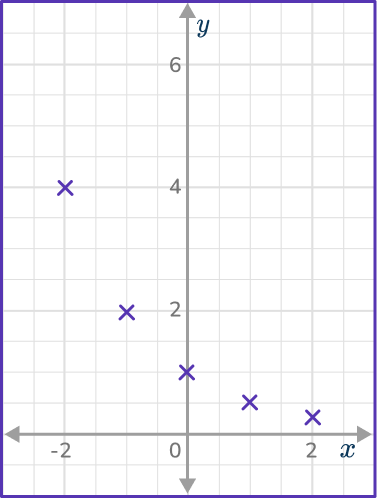
Draw a smooth curve through the points.
Use a pencil and turn the paper around if it makes it easier for you.
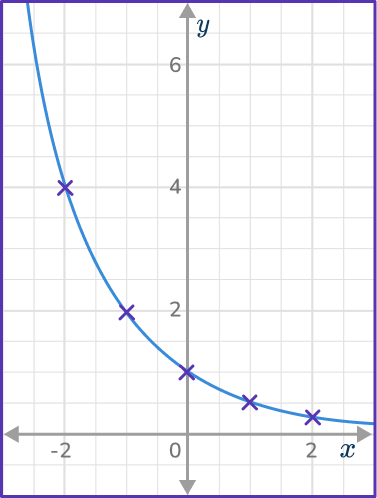
How to find the equation of an exponential function graph
In order to find the equation of an exponential function graph:
- Substitute the pairs of values into the given equation.
- Solve the two simultaneous equations.
- Write down the equation of the exponential function.
Finding the equation of an exponential function graph example
Example 5: finding the equation of an exponential graph.
The sketch shows a curve with equation y=ab^{x} where a and b are constants and b>0. Find the equation of the curve.
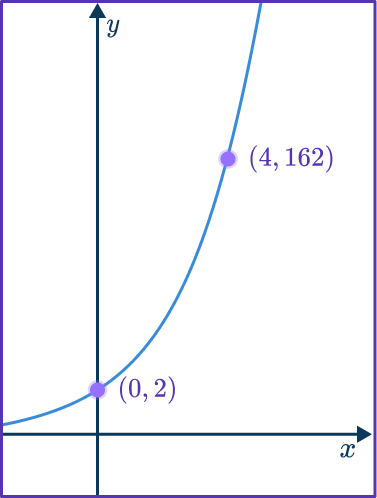
Substitute the pairs of values into the given equation.
The given equation is y=ab^{x}. Substituting (0, 2) into it would become
2=ab^0
Substituting (4, 162) into the equation would become
162=ab^4
Solve the two simultaneous equations.
Since anything to the power 0 is 1,
2=a\times{b}^{0}=a\times{1} so a=1.
Now look at the second equation 162=ab^4. Since a=2, this becomes
162=2\times b^4
This can be solved to find the base b.
Write down the equation of the exponential function.
The original equation was y=ab^x. Since a=2 and b=3, the equation is:
y=2\times 3^x
Example 6: finding the equation of an exponential graph.
The sketch shows a curve with equation y=ab^x where a and b are constants and b>0. Find the equation of the curve.
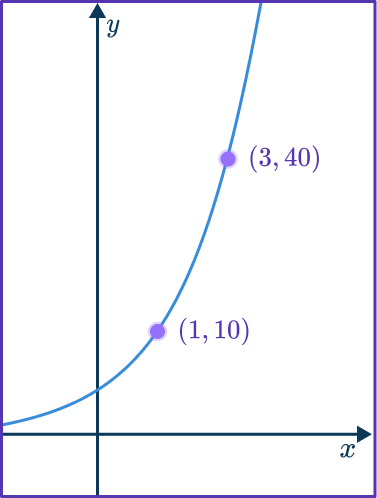
Substitute the pairs of values into the given equation.
The given equation is y=ab^x. Substituting (1, 10) into it would become
10=ab^1
Substituting (3, 40) into it would become
40=ab^3
Solve the two simultaneous equations.
Since anything to the power 1 is itself, this becomes
10=ab
Now look at the second equation.
40=ab^3
Solve these two equations by dividing one by the other to eliminate a.
\cfrac{40}{10}=\cfrac{ab^3}{ab}
This becomes,
4=b^2
This can be solved to find the base b .
Substitute b=2 into one of the equations to find a.
Write down the equation of the exponential function.
The original equation was y=ab^x. Since a=5 and b=2, the equation is:
y=5\times{2^x}
Teaching tips for exponential function graph
- Start with easier subsets of real numbers as the values for a and b before moving on to more complex rational functions, so that students can focus on the overall shape of the function instead of the calculations themselves.
- Choose worksheets that have a variety of question types and show the exponential function graph in a variety of ways.
- Let struggling students use a graphing calculator to explore patterns in exponential function graphs and to check their work until they are confident solving on their own.
Easy mistakes to make
- Using straight lines when graphing exponential functions
Do not join up the plotted points with straight lines like this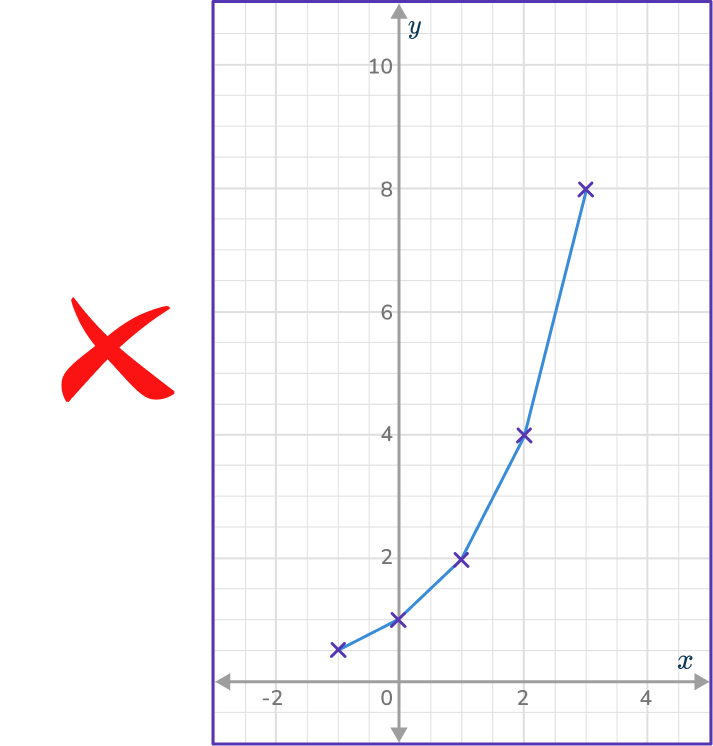
The points should be joined by a single, smooth curve.
- All points are not on the curve
If there is a point that does not join up with the other points when you draw a smooth curve – go back and check the coordinate. In the example below there is a point that does not lie on the smooth curve so needs checking.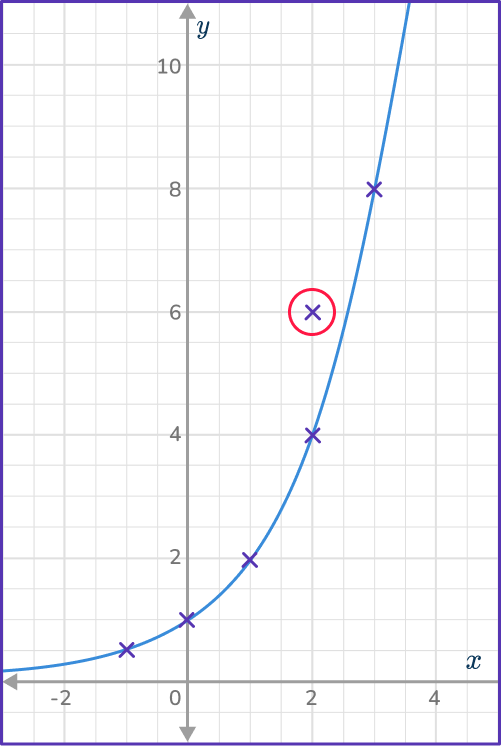
- Applying the exponent to both variables in an exponential equation
It is common to confuse y=ab^{x} with y=(ab)^{x}. However, each will result in different y values when substituting into a calculator or plotting a graph. y=ab^{x} means y=a\times(b^x) and treating it like y=(ab)^{x} will not result in the same function.
- Confusing exponent notation
This mistake is particularly common for fractional exponents and negative exponents.
For example, substituting \cfrac{1}{2} for x in the function y=2\left(9^x\right), is equal to y=2\cdot\sqrt{9}=2(3)=6.
The \cfrac{1}{2} fraction as an exponent operates like a square root and the square root of 9 is 3.
Substituting - \, 2 for x in the function y=2\left(9^x\right), is equal to y=2\cdot\cfrac{1}{9^2}=\cfrac{2}{81}.
The - \, 2 as an exponent operates the reciprocal to be multiplied by itself 2 times.
Related types of graphs lessons
Practice exponential graph questions
1. Identify the correct equation for the exponential growth function:
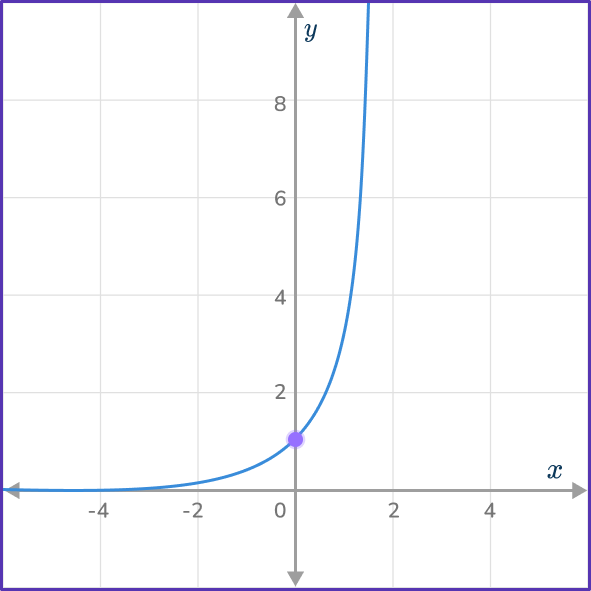




The curve is a growth curve; its equation will be an exponential function.
y=6^{x} is an exponential function.
y=6x+1 is a linear function; its graph would be a straight line.
y=x^{2}+1 is a quadratic function; its graph would be a parabola.
y=\cfrac{6}{x} is an inverse function; its graph would be a hyperbola.
2. Identify the correct equation for the graph:
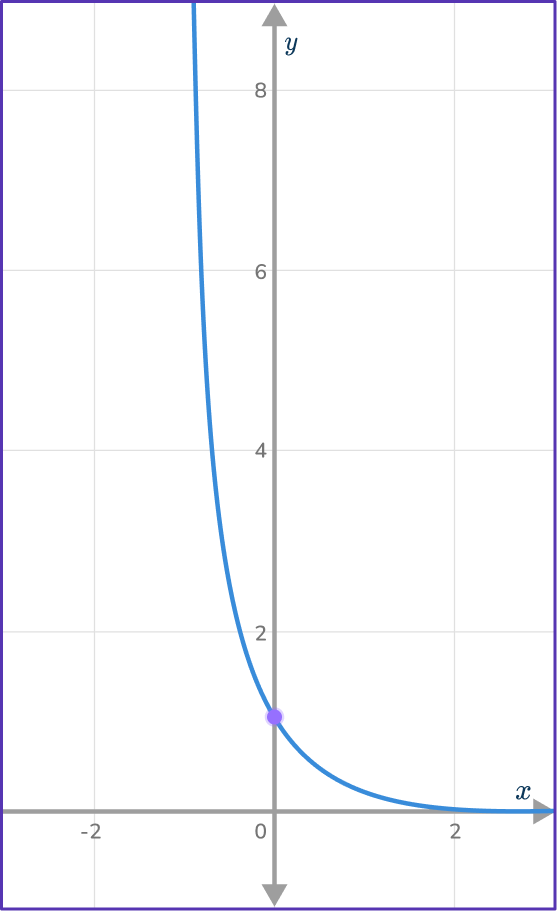




The curve is a decay curve; its equation will be an exponential function.
y=0.1^{x} is an exponential function.
y=1-10x is a linear function; its graph would be a straight line.
y=x^{2}+1 is a quadratic function; its graph would be a parabola.
y=x^{3}+1 is a cubic function.
3. Identify the correct graph for the equation: y=10^x.
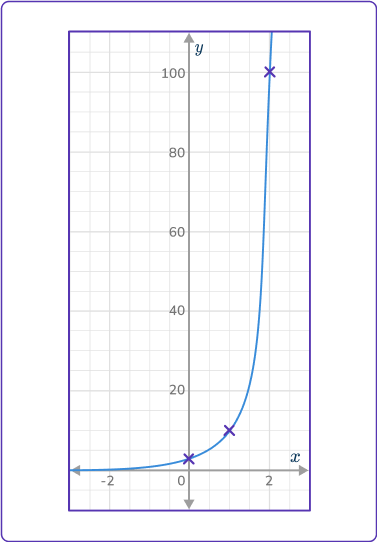

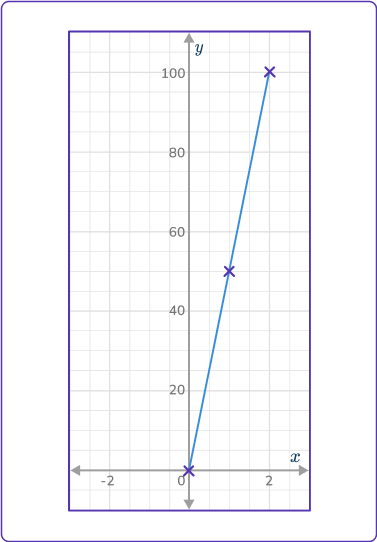

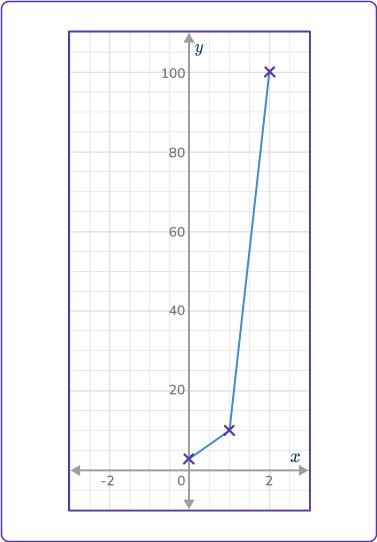

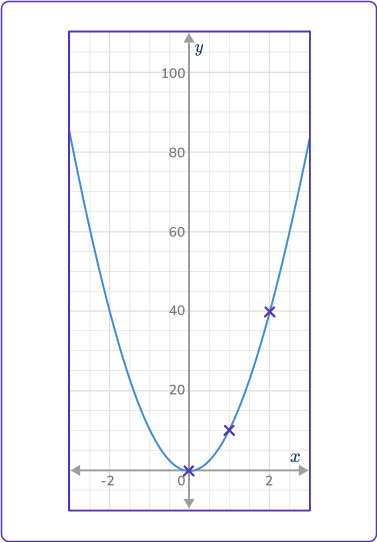

A correct table of values would be:

These x -values and y -values give coordinates such as (0, 1), (1, 10) and (2, 100).
The coordinates are plotted on the grid. A smooth curve should be drawn through the points. The curve is increasing, because it is a growth function.
4. Identify the correct graph for the equation: y=\left(\cfrac{1}{5}\right)^{x}.
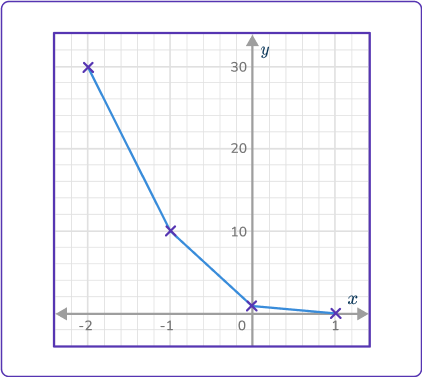

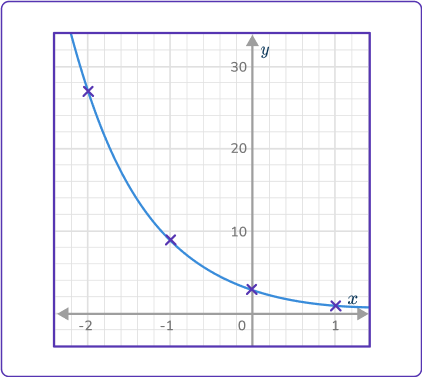

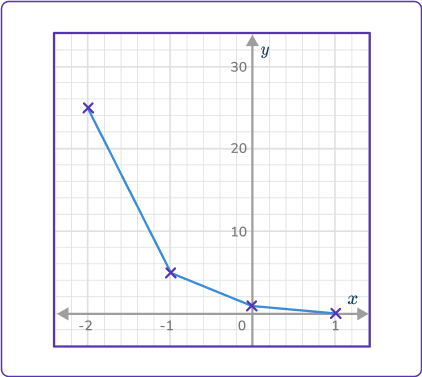

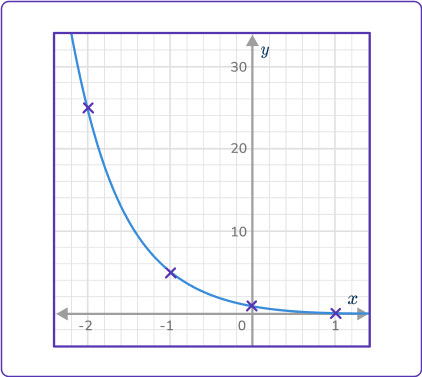

A correct table of values would be:

These x -values and y -values give coordinates such as (- \, 2, 25), (- \, 1, 5) and so on.
The coordinates are plotted on the grid. A smooth curve should be drawn through the points. The curve is decreasing, because it is a decay function.
5. Find the equation of the curve in the form y=ab^x where a and b are constants and b>0.
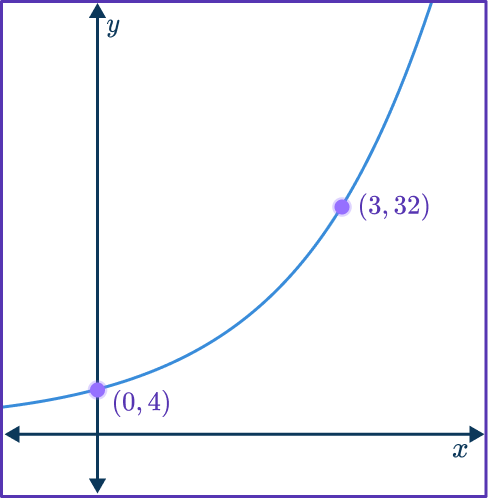




Substituting the coordinates into the given equation gives
4=ab^0=a
Now we need to find the base b
\begin{aligned}32&=ab^{3} \\\\ 32&=4\times{b^3} \\\\ 8&=b^{3} \\\\ b&=\sqrt[3]{8} \\\\ b&=2 \end{aligned}
So the equation is:
y=4\times{2^x}
6. Find the equation of the curve in the form y=ab^x where a and b are constants and b>0.
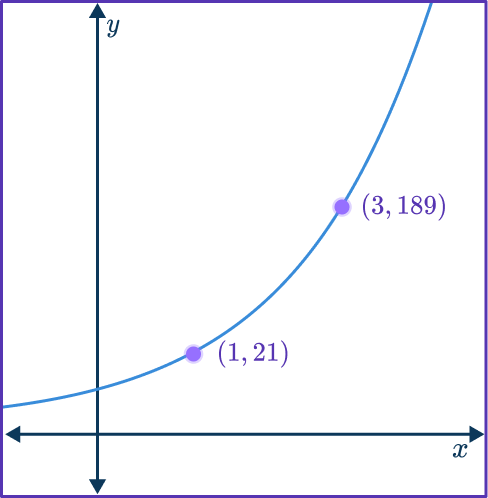




Substituting the coordinates into the given equation gives
21=ab^1=ab
189=ab^3
Dividing the two equations to eliminate a
\begin{aligned}\cfrac{189}{21}&=\cfrac{ab^3}{ab} \\\\ 9&=b^2 \\\\ b&=\sqrt{9} \\\\ b&=3 \end{aligned}
Substitute b=3 into one of the equations to find a.
\begin{aligned}21&=ab \\\\ 21&=a\times{7} \\\\ a&=3 \end{aligned}
So the equation is:
y=7\times{3^x}
Exponential function graphs FAQs
There is no value of x when y is equivalent to 0 in an exponential function.
No, in different types of equations the asymptote may be vertical or any type of linear equation.
The addition of the constant 5 causes a horizontal shift in the graph of the function.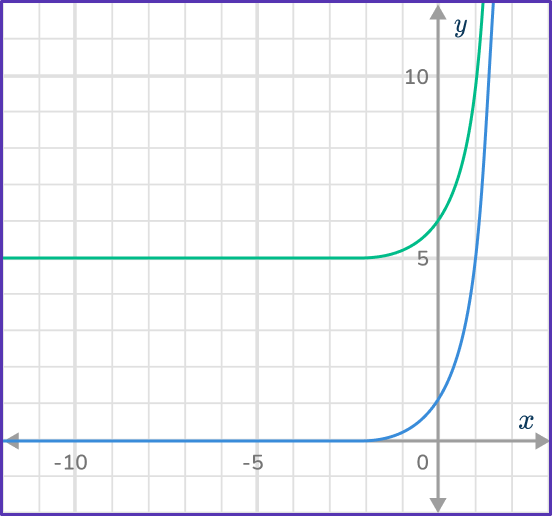
The next lessons are
- Graphing linear equations
- Rate of change
- Systems of equations
Still stuck?
At Third Space Learning, we specialize in helping teachers and school leaders to provide personalized math support for more of their students through high-quality, online one-on-one math tutoring delivered by subject experts.
Each week, our tutors support thousands of students who are at risk of not meeting their grade-level expectations, and help accelerate their progress and boost their confidence.

Find out how we can help your students achieve success with our math tutoring programs.
[FREE] Common Core Practice Tests (3rd to 8th Grade)
Prepare for math tests in your state with these 3rd Grade to 8th Grade practice assessments for Common Core and state equivalents.
Get your 6 multiple choice practice tests with detailed answers to support test prep, created by US math teachers for US math teachers!